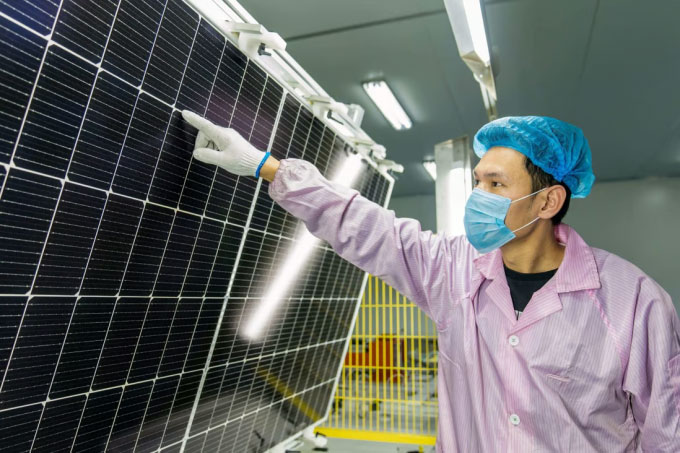With China producing 80% of the world’s solar panels, it holds a significant advantage in the renewable energy sector.
According to the International Energy Agency (IEA), spending on solar energy production is set to reach $380 billion this year. This marks the first time in history that this sector has surpassed spending on oil extraction, which stands at $370 billion.
Experts indicate that the world is transitioning from fossil fuels to renewable energy, particularly solar energy. Meanwhile, most photovoltaic panels are currently sourced from China. The IEA reports that China accounts for 80% of all solar panels produced globally. When considering the supply chain, the influence of the populous nation is even more pronounced: it produces 85% of photovoltaic components, 88% of polysilicon (the material that converts sunlight into electricity), and up to 97% of the thin film that protects solar cell cores.

Workers at GCL Poly Energy – one of the largest solar panel manufacturers in the world – inspecting panels at their factory in Jiangsu. (Photo: AFP).
China’s dominance in solar energy has occurred quite rapidly. In 2005, Europe led the race, with Germany alone accounting for one-fifth of global solar panel production. Just five years later, while the region continued to install solar energy, its production decreased. This year, for every ten solar panels sold on the market, eight are produced in China.
The rapid development of solar energy in China is primarily due to the country’s supportive policies, such as low capital and operational costs, quick project approvals, protection for domestic companies from foreign competition, low labor costs, an extensive supply chain network, and high domestic demand. These factors have contributed to China’s success as the world’s manufacturing powerhouse.
A Strategic Tool
“The geopolitical significance of solar energy becoming an alternative to oil is immense,” stated Graham Allison, a professor at Harvard University, in an interview with FT. “Why has the Middle East become the center of conflict over the past decade? Because countries there are major suppliers of oil and gas – the energy sources for the 20th-century economy. If, in the next decade, solar energy replaces a significant portion of oil, who will suffer the most and who will benefit?”
The United States and Europe have committed to halving emissions by 2030 and achieving net-zero emissions by 2050. Last September, Jake Sullivan, the U.S. National Security Advisor, emphasized that green technology is one of three areas of utmost importance alongside semiconductors and artificial intelligence – two sectors in which the U.S. is restricting China through bans. However, observers assess that the solar energy field will be quite different.
According to the Inflation Reduction Act, signed by President Joe Biden last August, the U.S. will provide $369 billion for green energy over the next decade, which includes $100 billion in grants for solar panel manufacturers and an additional $100 billion in tax incentives. Europe is also trending towards increased funding for renewable energy, much of which is directed towards solar power.
Nevertheless, the European solar industry is currently dependent on imports for most of its products from China. According to Alicia Garcia-Herrero, a senior fellow at the Bruegel think tank in Brussels, Europe needs to collaborate with the U.S. to create “an optimal green area.”
“If not, what will happen? Europe will continue to import everything from China, from storage batteries to solar panels, while the U.S. will develop its own ecosystem,” Garcia-Herrero told Bloomberg.
However, Allison notes that the U.S., Europe, and China all inhabit the same planet. Emissions will not only affect individual countries but will have global repercussions, to the extent that no one can thrive in the future.
“To ensure the survival of their citizens, leaders of these nations will need to find ways to cooperate alongside competing,” Allison expressed.


















































